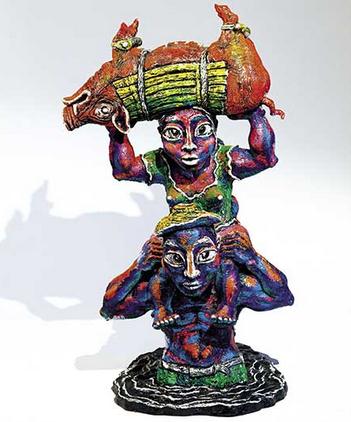
Crossing the River, painted on fiberglass by Luo Zhongli.(Photo provided to China Daily)
A new exhibition showcases the work of Luo Zhongli, who is regarded as the father of modern Chinese art.
Being the president of the Sichuan Fine Arts Institute has hindered his art, yet it was a price Luo Zhongli was willing to pay.
The 67-year-old artist, whose 1980 painting Father is recognized as a landmark in modern Chinese art, was speaking in Shanghai on June 10 for the opening of his exhibition The Art of Luo Zhongli in the historic Ampire Building on the Bund.
The exhibition, organized by the auction house Christie's, runs through July 15. This is the first time Christie's has presented a solo exhibition of a contemporary Chinese artist in Asia.
"When we look back for the beginning of China's contemporary art, and ask who opened the door to the new era, Luo Zhongli's Father and other works will inevitably come up in the discussion," says Zhang Dingyuan, vice-president of Christie's Asia.
Luo has continually refined his creative style, but his subjects have remained the same, says Zhuang Jun, an expert on 20th century and contemporary art at Christie's. "You always find love and humanity in his depiction of rural people," she says.
As a student of art at Sichuan Fine Arts Institute, Luo used to go to the countryside on long sketching tours, staying in the homes of people he met.
He remembers vividly the smoke and dark shadows, as the villagers told stories by the fire.
"They were tales of magic realism, so allegorical that they lingered on in my mind for many years. I have benefited from the experience ever since," Luo recalls.
He was a sophomore student at SFAI when he created the painting Father. China was recovering from the turmoil of the "cultural revolution" (1966-76) at the time. For decades art was reduced to being a propaganda tool. For this purpose, the subjects were supposed to be heroic, flawless and inspiring. No other style was acceptable.
But Luo boldly painted a large portrait of an old farmer with a darkened face and deep wrinkles, with one of his teachers stitching two canvases together by hand so that he would have a large enough canvas for his vision.
The painting won the gold prize at the second national youth art exhibition, the one and only national prize for art at that time.
Looking back, Luo says the technique and style he used were simply "photorealism", but the image was striking because it was in sharp contrast to the existing art of the time.
"Luo's work met the needs of the time," says Li Lei, an executive director of the China Art Museum Shanghai. "After the 'cultural revolution', individuals began to regain a position of significance. It was the ushering in of a new age of humanity and enlightenment."
Luo stayed on campus after graduation, teaching in the oil painting department. And he became one of the first artists to go abroad when China started to open up to the world, when he was granted a scholarship to study at the Academy of Fine Arts in Antwerp in Belgium in 1984.
It was during his three years' stay in Europe that Luo came to the conclusion that he had to "hold on to the root, in order to have good harvest".
He realized his root was the folk art of China, and he adopted its narratives, styles and aesthetics, borrowing their images of compositional techniques of traditional woodprints and paper cuttings. Eschewing perspective, he depicted his subjects flat, often outlined, as seen in folk arts, and he began to use saturated and bright primary colors.
In 2006 he went a step further to work on sculptures. But he didn't just create three-dimensional forms, he also painted on them.
One of the highlights at the exhibition is Crossing the River, a sculpture 143 centimeters high. It shows a man wading in water from the waist down, carrying his wife on the back. The wife carries a pig with its feet tied together on the top of her head, and their son holds tightly to her back. It is a powerful piece, and yet comical at the same time.
"Going to the market used to be a big deal in country life. Sometimes after it rained, the creeks flooded, and people would have to wade across," Lou explains. "Life was hard in the country. Now things are much different, but the natural bonds between people and people with nature are still the same, and will remain the same, I believe."
Lou took the job as director of SFAI in 1998, and says he spends a lot of time and effort on administrative tasks, particularly since the academy expanded to a new campus.
Running a college is like building a wine cellar, he says, you have to make sure every level functions well and wait patiently, then you will see great talents emerging.
















































